OLYMPIA - Finding current information about the state's salmon runs and tracking ongoing efforts to recover at-risk stocks on the Washington Department of Fish and Wildlife's (WDFW) website has never been easier.
A new online tool called the Salmon Conservation Reporting Engine (SCoRE) consolidates current information about state salmon populations, hatchery production, conservation guidelines and other aspects of salmon management in a single website.
The SCoRE website, available at http://wdfw.wa.gov/score/ , outlines major recovery initiatives under way around the state to restore salmon habitat, restructure hatchery operations and redesign fisheries to conserve wild runs.
While focusing on WDFW's role in these efforts, the website also provides information about an array of local and regional organizations, tribal governments and volunteer groups involved in the statewide effort. Readers can link directly to salmon recovery efforts in their area, and to statewide information such as the annual State of the Salmon Report.
This information provides a context for SCoRE's detailed status reports on all biologically distinct salmon and steelhead populations around the state, describing their history, spawning escapement and recovery goals. This same information is also included for coastal cutthroat and bull trout populations, many of which are also listed for protection under the federal Endangered Species Act.
"Our goal was to make this information as easy to access as possible," said Sara LaBorde, a special assistant to the director at WDFW. "With SCoRE, people can switch from an overview of statewide habitat-restoration efforts to spawning data for a specific salmon run with a few mouse clicks."
Various issues addressed on the website include:
Which salmon and steelhead populations are increasing, decreasing, or showing no change?
What are specific salmon hatcheries doing to support salmon recovery?
Who is involved in the effort to restore wild salmon and steelhead runs?
What can individuals do to get involved in salmon recovery?
LaBorde said WDFW designed the website for a variety of users, including policy makers, scientists, department employees and the general public.
"Our state made a major commitment to salmon recovery, and people have right to know how that's going," she said. "By providing a common base of information, we also hope this website will encourage more people to get involved in this effort."
Like salmon recovery itself, the new website is a work in progress, said LaBorde, noting that WDFW will continue to add information to the SCoRE reporting system throughout the recovery effort.
December 17th - Eva's Wild Salmon Pop Up 12-6pm
 Emerald Water Anglers
Emerald Water Anglers

Cart
Your cart is currently empty.
Your subtotal today is $-.--. Shipping and taxes will be calculated at checkout.
Go to cart- EWA Gift Cards
-
Shop Online
- Shop All Categories
- EWA Gift Cards
- Fly Rods | Single Hand
- Spey Rods | Two Handed
- Fly Reels
- Fly Lines | Single Hand
- Spey Lines | Heads | Running Lines
- Leader | Tippet
- Waders & Boots | Women
- Waders & Boots | Men
- Outerwear | Women
- Outerwear | Men
- Apparel | Women
- Apparel | Men
- Sunglasses | Accessories
- Fly Assortments | Flies
- Packs | Bags | Travel Equipment
- Hats | Gloves | Socks | Belts
- Nets | Accessories
- Accessories
- Fly Tying | Materials | Tools | Vises
- Coolers | Drinkware | Food | Turtlebox
- Boats | Float Tubes | SUP
- Books | Magazines
- Art | Jewelry | Photography
- Pliers | Benchmade Knives
- Seattle Fly Fishing Reports
- Waters We Guide
- Classes and Schools
- Travel With EWA
- Event Calendar
- About Us
